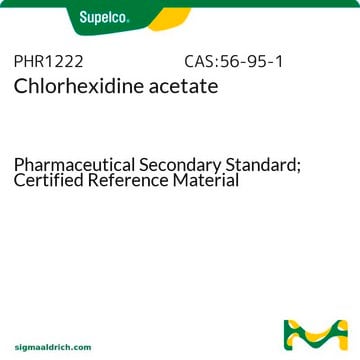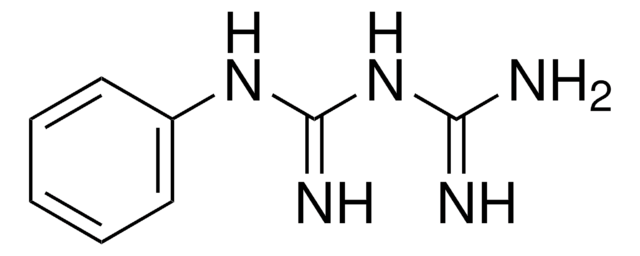C6143
Chlorhexidine diacetate salt hydrate
bis(biguanide) antimicrobial
Synonyme(s) :
1,6-Bis(N5-[p-chlorophenyl]-N1-biguanido)hexane; 1,1′-Hexamethylenebis(5-[p-chlorophenyl]biguanide)
About This Item
Produits recommandés
Forme
powder
CMC
0.01% (25°C)(w/v)
Solubilité
ethanol: 50 mg/mL
Spectre d'activité de l'antibiotique
Gram-negative bacteria
Gram-positive bacteria
Mode d’action
cell membrane | interferes
Température de stockage
room temp
Chaîne SMILES
ClC1=CC=C(NC(NC(NCCCCCCNC(NC(NC2=CC=C(Cl)C=C2)=N)=N)=N)=N)C=C1.OC(C)=O.OC(C)=O
InChI
1S/C22H30Cl2N10.2C2H4O2/c23-15-5-9-17(10-6-15)31-21(27)33-19(25)29-13-3-1-2-4-14-30-20(26)34-22(28)32-18-11-7-16(24)8-12-18;2*1-2(3)4/h5-12H,1-4,13-14H2,(H5,25,27,29,31,33)(H5,26,28,30,32,34);2*1H3,(H,3,4)
Clé InChI
WDRFFJWBUDTUCA-UHFFFAOYSA-N
Application
Actions biochimiques/physiologiques
Autres remarques
Clause de non-responsabilité
Mention d'avertissement
Warning
Mentions de danger
Conseils de prudence
Classification des risques
Acute Tox. 4 Oral - Aquatic Acute 1 - Aquatic Chronic 1 - Eye Irrit. 2 - Skin Irrit. 2 - STOT SE 2
Organes cibles
Liver,Teeth
Code de la classe de stockage
11 - Combustible Solids
Classe de danger pour l'eau (WGK)
WGK 3
Point d'éclair (°F)
Not applicable
Point d'éclair (°C)
Not applicable
Équipement de protection individuelle
Eyeshields, Gloves, type N95 (US)
Certificats d'analyse (COA)
Recherchez un Certificats d'analyse (COA) en saisissant le numéro de lot du produit. Les numéros de lot figurent sur l'étiquette du produit après les mots "Lot" ou "Batch".
Déjà en possession de ce produit ?
Retrouvez la documentation relative aux produits que vous avez récemment achetés dans la Bibliothèque de documents.
Les clients ont également consulté
Notre équipe de scientifiques dispose d'une expérience dans tous les secteurs de la recherche, notamment en sciences de la vie, science des matériaux, synthèse chimique, chromatographie, analyse et dans de nombreux autres domaines..
Contacter notre Service technique











